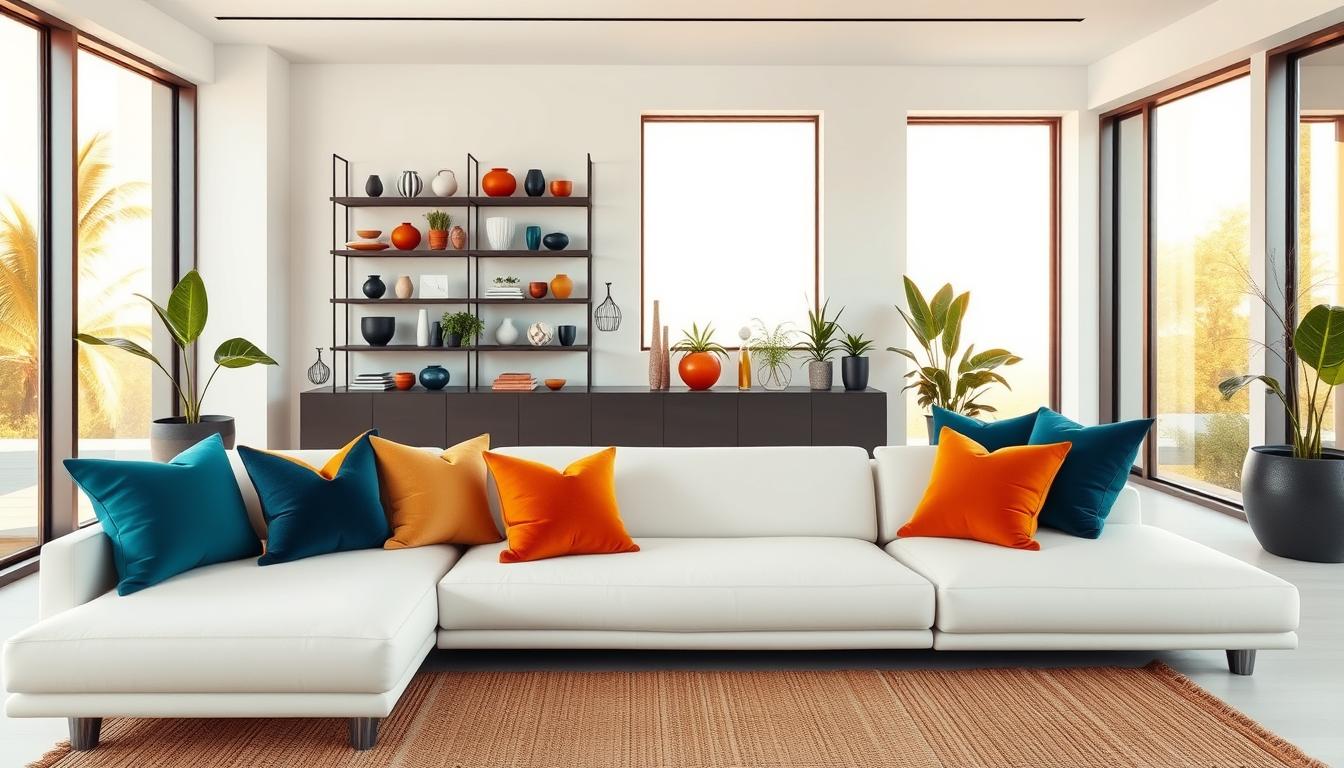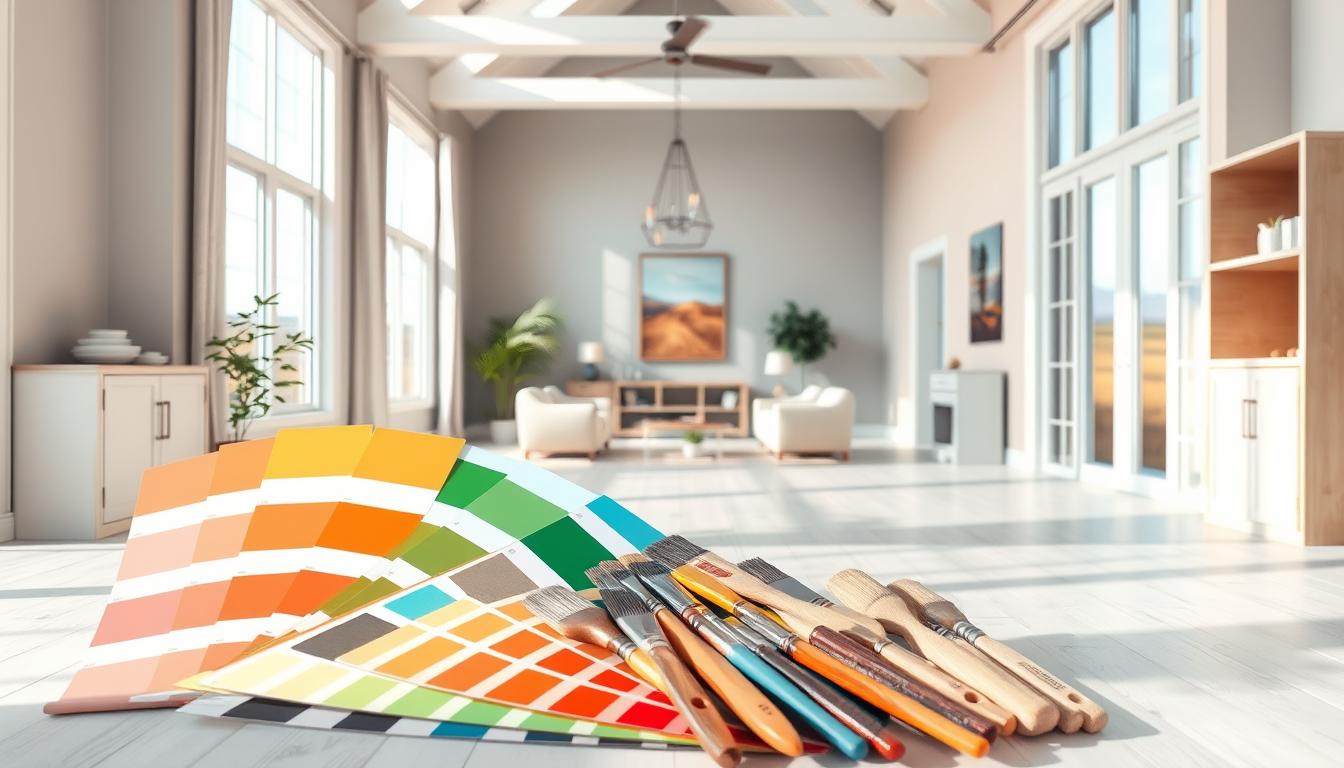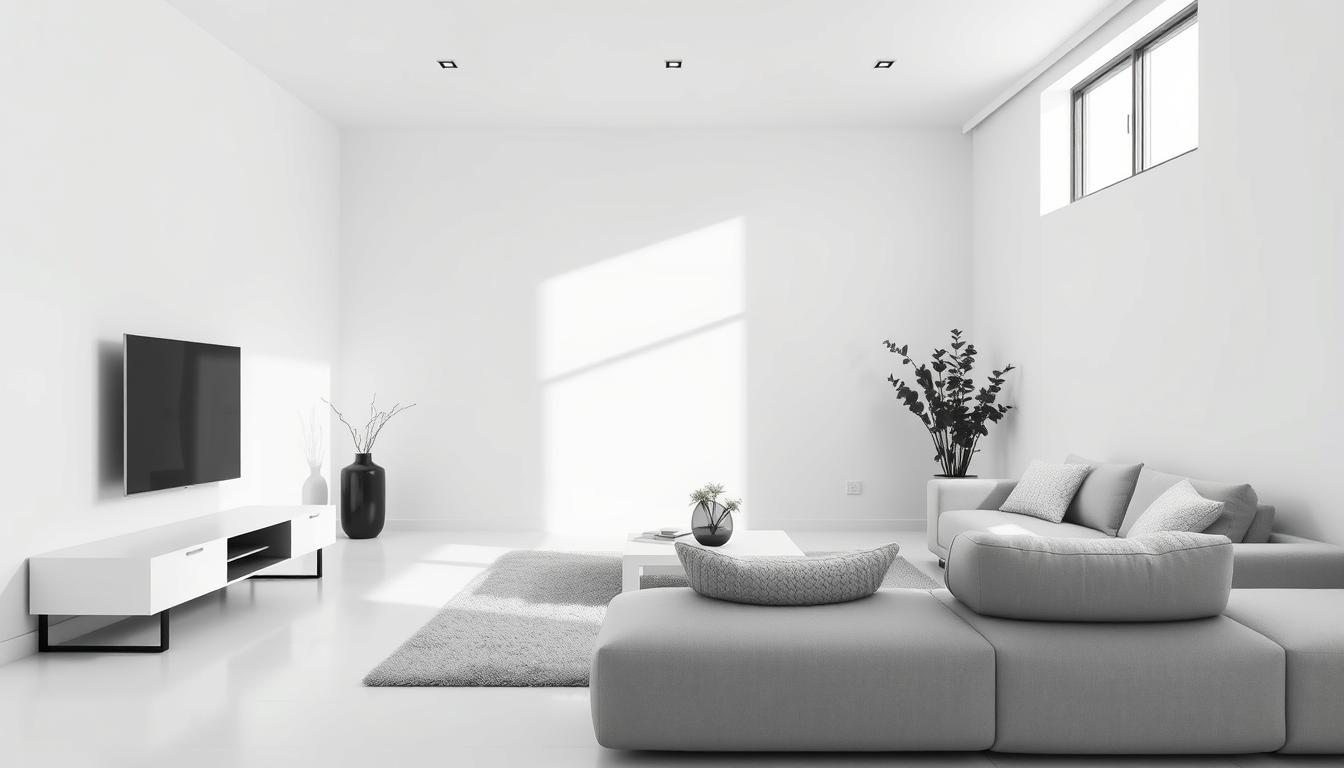Did you know the right color scheme can boost a property’s value by up to 5%? Picking the perfect colors for your living space is key. It shows your personality and sets the mood for your stylish space. We’ll show you how to choose colors that make your space look better.
Using the right colors can make your dwelling feel welcoming and balanced. Our advice will guide you through modern home colors. You’ll learn how to pick colors that improve your space.
Key Takeaways
- Understand the impact of color on property value
- Learn how to choose the right colors for your living space
- Discover contemporary color schemes to elevate your space
- Create a harmonious and inviting atmosphere
- Make informed decisions with our expert tips
Understanding the Psychology of Color in Home Interiors
Choosing the right colors for our home interiors is more than just a personal choice. It’s about creating a space that supports our mental and emotional health. The colors we surround ourselves with can greatly affect our mood, energy, and overall well-being.
How Colors Impact Mood
Different colors can make us feel different ways. For example, warm colors like oranges and reds can make us feel energized. On the other hand, cool colors like blues and greens can calm us down. Knowing this can help us pick colors that make us feel good and support our lifestyle.
“Colors, much like music, can be a universal language, touching our emotions and inspiring us in profound ways,” a renowned interior designer once said. This shows how important it is to choose colors that connect with our personal experiences and preferences.
Choosing Colors for Different Rooms
The purpose of a room should guide our color choices. For instance, a bedroom might need soothing colors to help us relax. On the other hand, a home office might require more stimulating colors to boost productivity. We should think about the room’s purpose and the activities we’ll do there when picking our stylish room color palettes.
- Bedrooms: Soft blues, pale lavenders
- Home Offices: Vibrant greens, energizing yellows
- Living Rooms: Warm neutrals, rich browns
The Role of Natural Light
Natural light can change how colors look in our homes. A color that looks great in a bright room might look different in a room with less light. We need to think about the natural light in each room when choosing our trending house paint colors to get the best look.
By understanding how color, natural light, and room function work together, we can make interiors that are not just beautiful but also good for our well-being.
Popular Color Trends for Modern Homes
The latest color trends in modern home design focus on balance. They aim to mix beauty with comfort. We see certain colors and trends becoming more popular in interior design.
Trending Neutral Palettes
Neutral colors are key in modern homes. Shades like white, beige, and gray are timeless. They also let you add bold colors and statement pieces easily.
These neutral tones make spaces feel calm and serene.
Some top neutral palettes include:
- Soft whites and creams
- Warm beiges and taupes
- Cool grays and blues
Bold Accent Colors
Neutral colors offer a calm base. But, bold accent colors add personality and energy. Colors like deep blues, rich greens, and vibrant yellows can make a room pop.
“Accent colors can completely transform a room, adding energy and personality to the space.”
Choosing bold accent colors depends on the mood you want. For example, bold reds and oranges can energize a room. Soft pastels can make it calm.
Nature-Inspired Tones
Nature-inspired colors are getting more popular. They bring the outdoors in. Colors like terracotta, sage green, and sandy beige make spaces warm and inviting.
| Nature-Inspired Tone | Description | Ideal Room |
|---|---|---|
| Terracotta | Warm, earthy red tone | Living Room, Kitchen |
| Sage Green | Soft, muted green | Bedroom, Bathroom |
| Sandy Beige | Light, neutral beige | Any Room |
Using these color trends can make your home stylish and cozy. Whether you like neutral colors, bold colors, or nature-inspired tones, there’s something for everyone.
Creating a Cohesive Color Scheme
Creating a cohesive color scheme is key for a harmonious home. A well-chosen color scheme ties rooms and elements together. This creates a sense of continuity and flow.
To achieve this, we can follow some key principles. One effective method is the 60-30-10 rule. It divides the color palette into 60% of a dominant color, 30% of a secondary color, and 10% of an accent color. This balance makes for a visually appealing and harmonious space.
The 60-30-10 Rule
The 60-30-10 rule is a simple yet effective way to create a cohesive color scheme. We allocate 60% of the room to a dominant color, usually through walls and large furniture pieces. This establishes the base tone.
The secondary color, making up 30%, is introduced through smaller furniture items and rugs. It adds depth to the space. The accent color, making up 10%, is used sparingly in decorative items. It adds a pop of color and creates visual interest.
Mixing Patterns and Textures
Mixing patterns and textures is crucial for a cohesive color scheme. Combining different patterns and textures adds depth and visual interest to a room. For example, pairing a smooth leather sofa with a chunky woven rug and patterned throw pillows creates a rich and inviting atmosphere.
It’s essential to choose patterns and textures that complement each other in terms of color and style. This maintains cohesion.
For more inspiration on mixing patterns and textures, check out our top home design interior tips for a stylish space on Satori Loka.
Consistency in Color Choices
Consistency is key to a cohesive color scheme. We should aim to use a consistent color palette throughout the home. This creates a sense of continuity.
This doesn’t mean every room has to be the same. We can use variations of our chosen colors in different rooms. For example, if we’ve chosen a calming blue as our dominant color, we can use different shades of blue in various rooms to create a cohesive look.
By following these principles and staying true to our chosen color palette, we can create a chic and harmonious home interior. It reflects our personal style and incorporates current color trends for modern homes.
Choosing the Right Paint Finish
The finish of your paint is as important as the color in modern homes. The right finish can make your home look better. The wrong one can make it look worse. We’ll help you choose a finish that fits your style.
The Difference Between Matte and Glossy
Matte and glossy finishes differ in sheen and durability. Matte finishes are flat and hide imperfections well. But, they’re less durable and stain easily. Glossy finishes are shiny and last longer, but show more.
“Matte finishes are sophisticated and understated,” says Jane Smith, an interior design expert. “Glossy finishes add elegance and sophistication.” Your choice depends on the room’s purpose and feel you want.
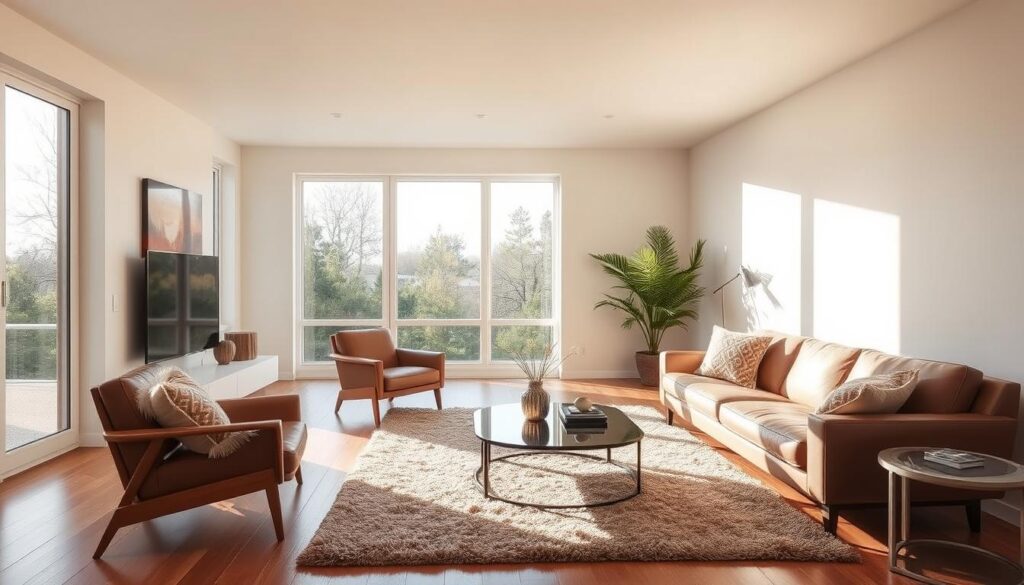
When to Use Satin vs. Semi-Gloss
Satin and semi-gloss finishes are in between matte and glossy. Satin finishes are durable and easy to clean, good for living areas and bedrooms. Semi-gloss finishes are even more durable and moisture-resistant, perfect for kitchens and bathrooms.
- Satin finishes are great for busy areas because they’re durable.
- Semi-gloss finishes are best for wet areas, like bathrooms.
Gloss Finish for Modern Aesthetics
Gloss finish is bold and modern, adding sleekness to a room. It’s good for accent walls and furniture. But, think about the room’s style and lighting, as gloss can be too much.
“High-gloss paint can make a dramatic statement, but it requires careful consideration of the room’s overall design to avoid a overwhelming effect.”
Knowing about paint finishes helps you choose the right one for your home. Whether you want a subtle matte look or a bold glossy statement, the right finish is key to your desired look.
Using Color to Define Spaces
Homeowners can make different areas in their homes using colors. This makes the home look better and work better too. It helps by setting up spaces for different things.
Open Concept Living Areas
Open-concept living areas can be tricky to divide. But, we can use trending house paint colors to make different areas look distinct. For example, painting the dining area a different color than the living room helps define each space.
Here are some ways to do it:
- Use a bold accent wall to split the living area from the dining space.
- Choose different shades of the same color to keep things looking good while dividing areas.
- Add color with furniture and decor to make spaces clear.
Cozy Nooks with Color
To make cozy nooks, use warm, inviting colors. These spots are great for relaxing or reading. To make a cozy nook, try:
- Warm, earthy tones for comfort.
- Soft lighting for a cozy feel.
- Comforting textiles and furniture to invite you in.
Highlighting Architectural Features
Color can make architectural features like built-in shelves or columns stand out. Painting them in a contrasting color adds character to the room.
Here’s how to highlight architectural features:
- Choose a color that goes with the main scheme but stands out.
- Use a semi-gloss or gloss finish to make it pop.
- Make sure the color doesn’t clash with other room elements.
Incorporating Accent Walls
An accent wall can make your home look better and more interesting. These walls can be bold, add texture, or be a room’s main focus.
Ideas for Bold Accent Walls
There are many ways to make an accent wall stand out. You can pick a bright color or a textured finish. Some popular interior design hues include deep blues, rich greens, and bold yellows. Think about the room’s use and your style when picking a color or texture.
How to Choose the Right Wall
Picking the right wall for your accent wall is key. Look for a wall that catches your eye, like one behind a fireplace or a big piece of furniture. Also, think about the wall people see when they enter the room. The goal is to make a focal point that improves the room’s look.
The Impact of Wallpaper
Wallpaper is a great way to make an accent wall. There are many patterns and designs to choose from. You can pick one that fits your room’s style and adds something special. Wallpaper can make your accent wall more interesting and add depth.
When adding an accent wall, make sure it matches the rest of your room. This way, you’ll have a space that looks good and shows off your style. It should also follow modern home color trends.
Color Combinations That Work
Choosing the right colors is key to making your living space beautiful and useful. It’s important to pick colors that go well together. This creates a welcoming and harmonious atmosphere.
We’ll look at three main areas. First, classic color pairs that never go out of style. Then, modern contrasts for a sophisticated look. Lastly, seasonal colors to keep your home looking fresh.
Classic Color Pairings
Classic color pairs are timeless and versatile. They’re perfect for any room. For example, navy blue and white make a clean, crisp look great for kitchens and bathrooms. Earth tones with cream add warmth and coziness to living areas and bedrooms.
These classic pairs are pleasing to the eye and a solid base for modern trends. Starting with a timeless base makes it easy to add trendy colors.
Modern Color Contrasts
For a modern look, try bold color contrasts. Pair deep jewel tones like emerald green or sapphire blue with neutral backgrounds for a striking effect. Or, pair bright, bold colors with dark accents for a dramatic feel.
When using bold contrasts, balance is key. You want to avoid overwhelming the space. This balance creates a chic, sophisticated look.
Seasonal Color Inspirations
Changing your home’s colors with the seasons keeps it feeling fresh. For spring, use pastel colors and soft florals to bring renewal indoors. In fall, warm up with rich, autumnal hues like orange, red, and yellow.
Seasonal colors refresh your home and let you try new combinations. This ensures your home always looks its best.
Color in Furniture and Decor
Using color in furniture and decor is key to a welcoming living space. Modern home interior colors show that furniture and decor are more than just useful. They help bring your color scheme to life.
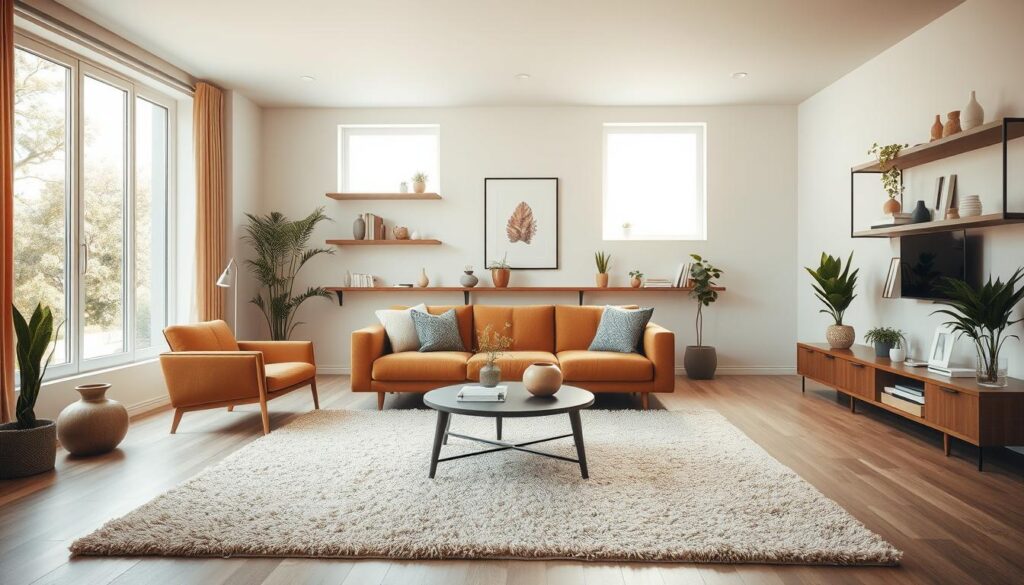
Statement Furniture Pieces
Statement furniture can totally change a room’s vibe. A bold sofa or an armchair in a bright color can grab attention. Pick furniture that fits with or contrasts your room’s colors for interest.
A colorful ottoman can brighten up a room with neutral colors. “Color is a power which directly influences the soul,” Wassily Kandinsky said. This shows how color affects our spaces emotionally.
“Color is a power which directly influences the soul.” – Wassily Kandinsky
Colorful Accessories and Textiles
Accessories and textiles are great for adding color. Throw pillows, blankets, and rugs in different colors can warm up a room. They’re easy to change to update your look or match the seasons.
For colorful accessories, use the 60-30-10 rule. Choose your main color for 60% of the room, a secondary color for 30%, and an accent color for 10%. This balance makes your space look good and feel right.
Incorporating Art into Your Palette
Art is a great way to add new colors and make your space personal. Whether it’s a bold piece or a calm landscape, art can tie your colors together or add contrast.
When adding art, think about your room’s colors. Look for art that matches or contrasts them. This creates a unified look and lets you express yourself.
Tips for Small Spaces
In small spaces, color can make a big difference. We’ll show you how to pick the right colors to make your area feel bigger.
Light Colors for Illusion of Space
Light colors on walls and ceilings can make a room look bigger. Soft whites, creams, and pale grays are great for this. They reflect light, making your space feel brighter and more open.
Using Mirrors and Color
Mirrors can help make a room feel larger. Place a mirror opposite a window to reflect natural light. This makes the room look brighter and bigger. Using a light color on the wall opposite the mirror also helps, creating a sense of space.
Multi-Functional Color Choices
In small spaces, it’s key to choose colors that work well together. Pick a wall color that matches your furniture for a cohesive look. Think about your furniture and decor colors when picking paint to ensure a stylish room.
- Selecting a dominant color and using it consistently throughout the space.
- Using a secondary color for accents that can add depth and interest.
- Considering the 60-30-10 rule: 60% dominant color, 30% secondary color, and 10% accent color.
By following these tips, you can make even the smallest rooms look stylish and spacious.
Color Maintenance and Longevity
Investing in modern home color trends is exciting. But, it’s also key to know how to keep them looking great. Keeping your home’s colors bright and fresh makes it more welcoming and beautiful.
Keeping Colors Fresh and Vibrant
To keep your home’s colors looking their best, consider these tips:
- Regularly dust and clean surfaces to prevent dirt buildup, which can dull the colors.
- Use high-quality cleaning products that are safe for the surfaces you’re cleaning.
- Avoid exposing your walls to direct sunlight for extended periods, as this can cause fading.
Paint Care Tips
Proper paint care is essential for maintaining the color and integrity of your walls. Here are some tips:
- Touch up scratches and marks promptly to prevent them from becoming more noticeable.
- Use a gentle cleaning solution for walls, avoiding harsh chemicals that can damage the paint.
- Consider applying a clear coat or protective finish to high-traffic areas.
Timing Your Re-Painting
Knowing when to re-paint is crucial for keeping your home’s colors fresh. Consider re-painting:
- When you notice significant fading or discoloration.
- After major renovations or repairs that may have damaged the paint.
- As part of a regular maintenance schedule, ideally every 5-7 years, depending on the quality of the paint and the condition of the walls.
By following these guidelines, you can enjoy vibrant, long-lasting colors in your home. These colors will reflect the latest popular interior design hues and modern home color trends.
Final Thoughts on Modern Home Interior Colors
Exploring modern home interior colors shows us how the right colors can make a big difference. We’ve talked about color psychology, trends, and how to pick colors that work well together.
Choosing chic paint colors for your home is all about following the latest trends. Think about using neutral colors and bold accents. These can make your home look fresh and lively.
Key Takeaways
Our journey into interior colors shows how important it is to understand color psychology and pick the right paint finish. Using color to define spaces is key to creating a welcoming home.
Personal Expression through Color
We believe your home should show off your personality. This means using bold colors or unique furniture pieces. Your home should truly reflect your style and taste.
Confidence in Color Choices
With the knowledge from this article, you can make smart choices about your home’s colors. A bit of creativity and confidence can turn your dream home into a reality. Enjoy a space that’s both beautiful and functional.

